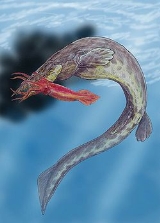
Hainosaurus
Encyclopedia
Hainosaurus is an extinct genus
of marine lizard
belonging to the mosasaur
family. It was one of the largest mosasaurs, though its size has been revised more than once. At first it was estimated to be 17 metres (55.8 ft), and the largest mosasaurid. During the 1990s, its size was revised to 15 metres (49.2 ft) long; more recently, Johan Lindgren estimated that it reached lengths of up to 12.2 metres (40 ft). It was one of the top marine predators of the Late Cretaceous
. These animals may have preyed on turtle
s, mosasaurs, plesiosaur
s, pterosaur
s, cephalopod
s, sharks and fish.
 Hainosaurus was a member of the Tylosaurinae, and it was related to the wholly North American Tylosaurus. However, it had more vertebrae from the neck to the part of the tail with chevrons
Hainosaurus was a member of the Tylosaurinae, and it was related to the wholly North American Tylosaurus. However, it had more vertebrae from the neck to the part of the tail with chevrons
(53) than Tylosaurus (35). Both genera are large marine superpredators. Hainosaurus tail has less chevron-bearing vertebrae, making it shorter than that of Tylosaurus. The only known and type
species of Hainosaurus is H. bernardi, named after Belgian
naturalist Leopold Bernard.
Genus
In biology, a genus is a low-level taxonomic rank used in the biological classification of living and fossil organisms, which is an example of definition by genus and differentia...
of marine lizard
Lizard
Lizards are a widespread group of squamate reptiles, with nearly 3800 species, ranging across all continents except Antarctica as well as most oceanic island chains...
belonging to the mosasaur
Mosasaur
Mosasaurs are large extinct marine lizards. The first fossil remains were discovered in a limestone quarry at Maastricht on the Meuse in 1764...
family. It was one of the largest mosasaurs, though its size has been revised more than once. At first it was estimated to be 17 metres (55.8 ft), and the largest mosasaurid. During the 1990s, its size was revised to 15 metres (49.2 ft) long; more recently, Johan Lindgren estimated that it reached lengths of up to 12.2 metres (40 ft). It was one of the top marine predators of the Late Cretaceous
Late Cretaceous
The Late Cretaceous is the younger of two epochs into which the Cretaceous period is divided in the geologic timescale. Rock strata from this epoch form the Upper Cretaceous series...
. These animals may have preyed on turtle
Turtle
Turtles are reptiles of the order Testudines , characterised by a special bony or cartilaginous shell developed from their ribs that acts as a shield...
s, mosasaurs, plesiosaur
Plesiosaur
Plesiosauroidea is an extinct clade of carnivorous plesiosaur marine reptiles. Plesiosauroids, are known from the Jurassic and Cretaceous Periods...
s, pterosaur
Pterosaur
Pterosaurs were flying reptiles of the clade or order Pterosauria. They existed from the late Triassic to the end of the Cretaceous Period . Pterosaurs are the earliest vertebrates known to have evolved powered flight...
s, cephalopod
Cephalopod
A cephalopod is any member of the molluscan class Cephalopoda . These exclusively marine animals are characterized by bilateral body symmetry, a prominent head, and a set of arms or tentacles modified from the primitive molluscan foot...
s, sharks and fish.

Chevron (anatomy)
A chevron is one of a series of bones on the ventral side of the tail in many reptiles, dinosaurs , and some mammals such as kangaroos and manatees....
(53) than Tylosaurus (35). Both genera are large marine superpredators. Hainosaurus tail has less chevron-bearing vertebrae, making it shorter than that of Tylosaurus. The only known and type
Type species
In biological nomenclature, a type species is both a concept and a practical system which is used in the classification and nomenclature of animals and plants. The value of a "type species" lies in the fact that it makes clear what is meant by a particular genus name. A type species is the species...
species of Hainosaurus is H. bernardi, named after Belgian
Belgium
Belgium , officially the Kingdom of Belgium, is a federal state in Western Europe. It is a founding member of the European Union and hosts the EU's headquarters, and those of several other major international organisations such as NATO.Belgium is also a member of, or affiliated to, many...
naturalist Leopold Bernard.

